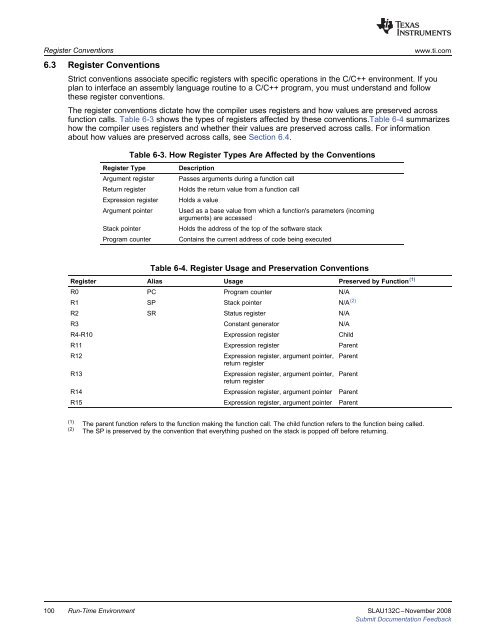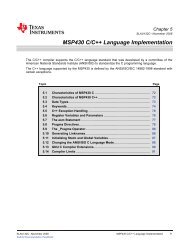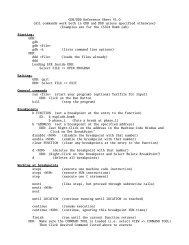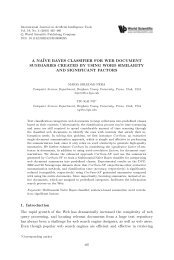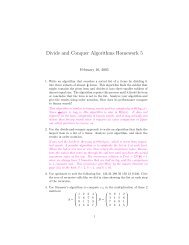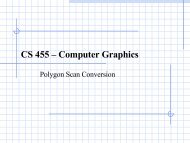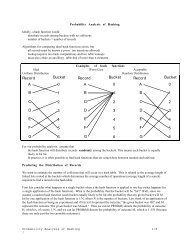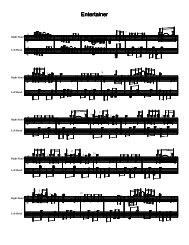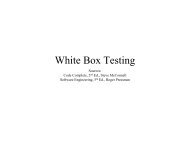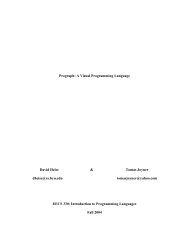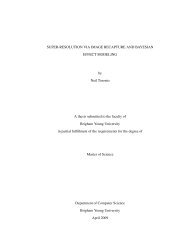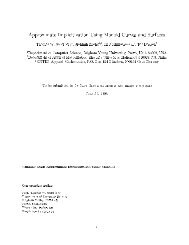MSP430 Optimizing C/C++ Compiler v 3.0 User's Guide (Rev. C
MSP430 Optimizing C/C++ Compiler v 3.0 User's Guide (Rev. C
MSP430 Optimizing C/C++ Compiler v 3.0 User's Guide (Rev. C
You also want an ePaper? Increase the reach of your titles
YUMPU automatically turns print PDFs into web optimized ePapers that Google loves.
Register Conventions6.3 Register Conventionswww.ti.comStrict conventions associate specific registers with specific operations in the C/<strong>C++</strong> environment. If youplan to interface an assembly language routine to a C/<strong>C++</strong> program, you must understand and followthese register conventions.The register conventions dictate how the compiler uses registers and how values are preserved acrossfunction calls. Table 6-3 shows the types of registers affected by these conventions.Table 6-4 summarizeshow the compiler uses registers and whether their values are preserved across calls. For informationabout how values are preserved across calls, see Section 6.4.Table 6-3. How Register Types Are Affected by the ConventionsRegister TypeArgument registerReturn registerExpression registerArgument pointerStack pointerProgram counterDescriptionPasses arguments during a function callHolds the return value from a function callHolds a valueUsed as a base value from which a function's parameters (incomingarguments) are accessedHolds the address of the top of the software stackContains the current address of code being executedTable 6-4. Register Usage and Preservation ConventionsRegister Alias Usage Preserved by Function (1)R0 PC Program counter N/AR1 SP Stack pointer N/A (2)R2 SR Status register N/AR3 Constant generator N/AR4-R10 Expression register ChildR11 Expression register ParentR12 Expression register, argument pointer, Parentreturn registerR13 Expression register, argument pointer, Parentreturn registerR14 Expression register, argument pointer ParentR15 Expression register, argument pointer Parent(1) The parent function refers to the function making the function call. The child function refers to the function being called.(2) The SP is preserved by the convention that everything pushed on the stack is popped off before returning.100 Run-Time EnvironmentSLAU132C–November 2008Submit Documentation Feedback
www.ti.com6.4 Function Structure and Calling ConventionsFunction Structure and Calling ConventionsThe C/<strong>C++</strong> compiler imposes a strict set of rules on function calls. Except for special run-time supportfunctions, any function that calls or is called by a C/<strong>C++</strong> function must follow these rules. Failure to adhereto these rules can disrupt the C/<strong>C++</strong> environment and cause a program to fail.The following sections use this terminology to describe the function-calling conventions of the C/<strong>C++</strong>compiler:• Argument block. The part of the local frame used to pass arguments to other functions. Argumentsare passed to a function by moving them into the argument block rather than pushing them on thestack. The local frame and argument block are allocated at the same time.• Register save area. The part of the local frame that is used to save the registers when the programcalls the function and restore them when the program exits the function.• Save-on-call registers. Registers R11-R15. The called function does not preserve the values in theseregisters; therefore, the calling function must save them if their values need to be preserved.• Save-on-entry registers. Registers R4-R10. It is the called function's responsibility to preserve thevalues in these registers. If the called function modifies these registers, it saves them when it gainscontrol and preserves them when it returns control to the calling function.Figure 6-2 illustrates a typical function call. In this example, arguments are passed to the function, and thefunction uses local variables and calls another function. The first four arguments are passed to registersR12-R15. This example also shows allocation of a local frame and argument block for the called function.Functions that have no local variables and do not require an argument block do not allocate a local frame.Before callFigure 6-2. Use of the Stack During a Function CallMove argumentsto argument block;call functionAllocate new framesand argument blockLowLowLowCallee’sargumentblockCallee’slocal variablesSPRegistersave areaCaller’sargumentblockCaller’slocal variablesSPArgument 5...argument nCaller’slocal variablesSPArgument 1 register R12Argument 2 register R13Argument 3 register R14Argument 4 register R15Argument 5...argument nCaller’slocal variablesHighRegistersave areaHighRegistersave areaHighRegistersave areaLegend:SP: stack pointerSLAU132C–November 2008 Run-Time Environment 101Submit Documentation Feedback
Function Structure and Calling Conventions6.4.1 How a Function Makes a Call6.4.2 How a Called Function Respondswww.ti.comA function (parent function) performs the following tasks when it calls another function (child function):1. The calling function (parent) is responsible for preserving any save-on-call registers across the call thatare live across the call. (The save-on-call registers are R11-R15.)2. If the called function (child) returns a structure, the caller allocates space for the structure and passesthe address of that space to the called function as the first argument.3. The caller places the first arguments in registers R12-R15, in that order. The caller moves theremaining arguments to the argument block in reverse order, placing the leftmost remaining argumentat the lowest address. Thus, the leftmost remaining argument is placed at the top of the stack.4. The caller calls the function.A called function (child function) must perform the following tasks:1. If the function is declared with an ellipsis, it can be called with a variable number of arguments. Thecalled function pushes these arguments on the stack if they meet both of these criteria:• The argument includes or follows the last explicitly declared argument.• The argument is passed in a register.2. The called function pushes register values of all the registers that are modified by the function and thatmust be preserved upon exit of the function onto the stack. Normally, these registers are thesave-on-entry registers (R4-R10) if the function contains calls. If the function is an interrupt, additionalregisters may need to be preserved. For more information, see Section 6.6.3. The called function allocates memory for the local variables and argument block by subtracting aconstant from the SP. This constant is computed with the following formula:size of all local variables + max = constantThe max argument specifies the size of all parameters placed in the argument block for each call.4. The called function executes the code for the function.5. If the called function returns a value, it places the value in R12 (or R12 and R13 values).6. If the called function returns a structure, it copies the structure to the memory block that the firstargument, R12, points to. If the caller does not use the return value, R12 is set to 0. This directs thecalled function not to copy the return structure.In this way, the caller can be smart about telling the called function where to return the structure. Forexample, in the statement s = f(x), where s is a structure and f is a function that returns a structure, thecaller can simply pass the address of s as the first argument and call f. The function f then copies thereturn structure directly into s, performing the assignment automatically.You must be careful to properly declare functions that return structures, both at the point where theyare called (so the caller properly sets up the first argument) and at the point where they are declared(so the function knows to copy the result).7. The called function deallocates the frame and argument block by adding the constant computed inStep 3.8. The called function restores all registers saved in Step 2.9. The called function ( _f) returns.The following example is typical of how a called function responds to a call:func:; Called function entry pointPUSH.W r10PUSH.W r9 ; Save SOE registersSUB.W #2,SP ; Allocate the frame:: ; Body of function:ADD.W #2,SP ; Deallocate the framePOP r9 ; Restore SOE registersPOP r10RET; Return102 Run-Time EnvironmentSLAU132C–November 2008Submit Documentation Feedback
www.ti.com6.4.3 Accessing Arguments and Local VariablesInterfacing C and <strong>C++</strong> With Assembly LanguageA function accesses its local nonregister variables indirectly through the stack pointer (SP or R1) and itsstack arguments. The SP always points to the top of the stack (points to the most recently pushed value).Since the stack grows toward smaller addresses, the local data on the stack for the C/<strong>C++</strong> function isaccessed with a positive offset from the SP register.6.5 Interfacing C and <strong>C++</strong> With Assembly LanguageThe following are ways to use assembly language with C/<strong>C++</strong> code:• Use separate modules of assembled code and link them with compiled C/<strong>C++</strong> modules (seeSection 6.5.1).• Use assembly language variables and constants in C/<strong>C++</strong> source (see Section 6.5.2).• Use inline assembly language embedded directly in the C/<strong>C++</strong> source (see Section 6.5.4).6.5.1 Using Assembly Language Modules With C/<strong>C++</strong> CodeInterfacing C/<strong>C++</strong> with assembly language functions is straightforward if you follow the calling conventionsdefined in Section 6.4, and the register conventions defined in Section 6.3. C/<strong>C++</strong> code can accessvariables and call functions defined in assembly language, and assembly code can access C/<strong>C++</strong>variables and call C/<strong>C++</strong> functions.Follow these guidelines to interface assembly language and C:• You must preserve any dedicated registers modified by a function. Dedicated registers include:– Save-on-entry registers (R4-R10)– Stack pointer (SP or R1)If the SP is used normally, it does not need to be explicitly preserved. In other words, the assemblyfunction is free to use the stack as long as anything that is pushed onto the stack is popped back offbefore the function returns (thus preserving SP).Any register that is not dedicated can be used freely without first being saved.• Interrupt routines must save all the registers they use. For more information, see Section 6.6.• When you call a C/<strong>C++</strong> function from assembly language, load the designated registers witharguments and push the remaining arguments onto the stack as described in Section 6.4.1.Remember that a function can alter any register not designated as being preserved without having torestore it. If the contents of any of these registers must be preserved across the call, you mustexplicitly save them.• Functions must return values correctly according to their C/<strong>C++</strong> declarations. Double values arereturned in R12 and R13, and structures are returned as described in Step 1 of Section 6.4.1. Anyother values are returned in R12.• No assembly module should use the .cinit section for any purpose other than autoinitialization of globalvariables. The C/<strong>C++</strong> startup routine assumes that the .cinit section consists entirely of initializationtables. Disrupting the tables by putting other information in .cinit can cause unpredictable results.• The compiler assigns linknames to all external objects. Thus, when you are writing assembly languagecode, you must use the same linknames as those assigned by the compiler. See Section 5.10 for moreinformation.For identifiers to be used only in an assembly language module, ensure that they do not conflict with aC/<strong>C++</strong> identifier. Use a$oraconsistent prefix naming convention to create a different namespace forassembly identifiers.• Any object or function declared in assembly language that is accessed or called from C/<strong>C++</strong> must bedeclared with the .def or .global directive in the assembly language modifier. This declares the symbolas external and allows the linker to resolve references to it.Likewise, to access a C/<strong>C++</strong> function or object from assembly language, declare the C/<strong>C++</strong> object withthe .ref or .global directive in the assembly language module. This creates an undeclared externalreference that the linker resolves.SLAU132C–November 2008 Run-Time Environment 103Submit Documentation Feedback


